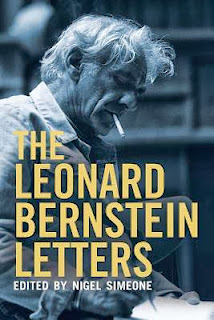Edited by Nigel Simeone
Genre: Classical
This 600 plus page book of letters by and to American composer/conductor/pianist Leonard Bernstein is a revelation. The first thing that becomes obvious is that Bernstein is a really good letter writer. The second thing is how well structured and thought-out this epistemological work is. The editor Nigel Simeone organized the lettesr chronologically and in divisions emphasizing phases of the composer's life. Then he provides a biographical summary for each phase. There are plenty of footnotes clarifying the things and persons mentioned in the letter which are just as fascinating as the letters themselves. The result ends up almost like a autobiography in that it covers most of the important aspect of his life. This is one of the few books of letters that I read enthusiastically from cover to cover.
Leonard Bernstein was a complex individual and the letters reveal this. There is much written about his music but there is also much revealed about the man's own personality, strengths and weaknesses. The letters begin in 1932 when Bernstein was 14 and continue to his death in 1990. The first letters are interesting in that they show a young protege in transition as he converses with his family and mentors. I was amused at all the important persons in his life that urged him to specialize in one thing rather than to stretch himself thin in the areas of composing, conducting, and performing. Bernstein did not take their advice and in hindsight we can say he made the right choice. The letters become much more revealing as he develop and is considered an equal by his peers. The letters between Bernstein and Aaron Copland are especially affectionate. In some ways they are more intimate than those between his wife in later years.
Which brings up a particular issue in his life. Bernstein came out about his homosexuality in the late 70s. Yet these letters, especially the earlier ones, show a man who was at times uncomfortable with his sexuality. The letters with his partners show much affection yet the 40s and 50s were not a time to be honest and open about this issue. Not to mention that the House of Unamerican Activities had their eye on him for many of his social concerns which they deemed suspicious. Some of the letters address this including an affidavit by the composer sent to the HUA that is disturbing in that any one would be so accused and expected to defend themselves in this way just to be able to continue to make a living. Later Bernstein's sexuality and habits became aa problem his marriage and these are addressed only briefly in later letters.
There are specific areas that I especially found interesting. There is an entire chapter on West Side Story mentioning many of the aspects that were involved in bringing this work to light. Being a clarinetist, I was very intrigued in his early Clarinet Sonata and his dialogues with clarinetist David Oppenheim. The sonata was Bernstein's first published work. There is a lot of good information on Bernstein's compositions and how they came about. If you are a music fanatic who likes to analyze compositions, you will have a field day here. I also enjoyed hearing about Bernstein's Mass as I was attended the Los Angeles premiere in the 70s at the Mark Taper Forum. But there are also plenty of letters that are simply casual and gives you a look at his daily life. One of the more endearing letter is a short one by 10 year old Yo Yo Ma inviting Bernstein to his cello recital.
Nigel Simeone does a surperb job organizing these letters and placing them in a context that not only educates but entertains; not a modest feat at all. If you enoy the music of Leonard Bernstein or have a love for 20th century classical music then this book is a must.
Background CD: Leonard Bernstein, Kiri Te Kanawa, Jose Carreras - Leonard Bernstein Conducts West Side Story

No comments:
Post a Comment